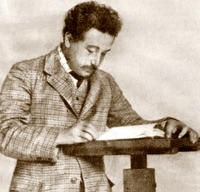100 Years of Energy/Mass Equivalence
 "The mass of a body is a measure of its energy content."
"The mass of a body is a measure of its energy content."So reads Albert Einstein's second paper on special relativity, which was received 100 year ago today by the Annalen der Physik, when Einstein worked as a technical expert in the Swiss patent office. This was the pentultimate paper in Einstein's annus mirabilis, in which he produced six scientific papers of historic significance:
1. The paper on the light quantum and the photoelectric effect, for which he won the Nobel prize. Max Planck discovered in 1900 that blackbody radiation behaves as if it is made of discrete units. Einstein declared that light interacts with matter in discrete units, a hypothesis so completely at odds with Maxwell's wave picture of electromagnetic radiation that he called it the heuristic principle rather than try to offer a physical expanation. According to biographer Abraham Pais, "[F]rom 1905 to 1923, [Einstein] was apart in being the only one, or almost the only one, to take the light-quantum seriously."Four of the these papers (the photoelectric effect, molecular dimensions and Brownian motion) reflect Einstein's virtuoso use of statistical techniques to reach fundamental conclusions. His work on Brownian motion, as Pais puts it, "enables us to demonstrate the reality of those motions we call heat, simply by looking into a microscope."
2. His doctoral thesis, a new determination of molecular dimensions, which according to Pais is the paper most quoted in modern scientific literature.
3. The first paper on Brownian motion, which like its two preceding papers presents a third fundamental method for determining Avogadro's number or N.
4. The first paper on special relativity, Euclidian in its structure and exposition.
5. The second paper on special relativity, in which we find the most famous equation in science.
6. The second paper on Brownian motion, which present two more methods for determining N.
The two papers on special relativity are constructed from two postulates: (1) the laws of physics are invariant in all inertial frames of reference and (2) the speed of light is invariant for observers in all intertial reference frames. With these two postulates, Einstein solved the problem of what Poincare and Lorentz called local time, by demonstrating that there is no absolute time, only time as measured in any given reference frame. As for the ether, believed to be the medium in which light is propagated, Einstein rendered it redundant.
With the exception of the light quantum, Einstein's astonishing output gained rapid acceptance. Max Planck was teaching special relativity to his students by the end of 1905.
Einstein's Annus Mirabilis 1905 is a good place to find material by and about Einstein. The one essential Einstein biography is "Subtle is the Lord" by physicist Abraham Pais. While heavy going with tons of equations, it best presents the meaning and importance of Einstein's science.
(Photo: www.einsteingalerie.de)



1 Comments:
Hi,
I like your article on Albert Einstein.
I would like to copy this article to my site.
My site magen.co.uk, is a non profit hobby. It provides an unusual Special relativity calculator...looks like the Israeli flag.. a novel interpretaion of the meaning of special relativity, which asserts an absolute truth. Plus additional information to distance the interpretation from association with the Israeli Flag.
All that i can offer in return for any permission to copy your article is that it would be on it's own page with a link to your Blog.
If you are agreeable please contact me at person@magen.co.uk Thankyou Vince
Post a Comment
<< Home